Indexed In
- Open J Gate
- JournalTOCs
- RefSeek
- Hamdard University
- EBSCO A-Z
- OCLC- WorldCat
- Scholarsteer
- Publons
- Geneva Foundation for Medical Education and Research
- Google Scholar
Useful Links
Share This Page
Journal Flyer

Open Access Journals
- Agri and Aquaculture
- Biochemistry
- Bioinformatics & Systems Biology
- Business & Management
- Chemistry
- Clinical Sciences
- Engineering
- Food & Nutrition
- General Science
- Genetics & Molecular Biology
- Immunology & Microbiology
- Medical Sciences
- Neuroscience & Psychology
- Nursing & Health Care
- Pharmaceutical Sciences
Editorial - (2021) Volume 9, Issue 8
Editorial on New Method to Detect Impact of Sea Level Rise
Sathvik Arava*Received: 16-Aug-2021 Published: 30-Aug-2021, DOI: 10.35248/2329-6798.21.9.321
Editorial
"Sulfur isotopes can reveal to us an extraordinary arrangement about Earth cycles both now and previously," said lead creator PhD understudy Emily Leyden from the University of Adelaide's School of Biological Sciences. "Diverse water sources have various degrees of sulfur isotopes inside them. The cycles that happen inside a climate like the interruption of seawater into freshwater frameworks, and oxidation of corrosive sulfate soils, can change these proportions. By examining sulfur isotope proportions we can acquire significant bits of knowledge into how conditions are evolving." The customary technique for estimating sulfur isotopes is known as mass spectroscopy (MS), where tests are ionized (parted into their particles) and the particles of interest in the examples are estimated relying upon their mass to charge proportion, which contrasts between isotopes of a similar compound component. The customary strategy has been famously troublesome, as the mass to charge proportion among particles can scatter and cover, which can make the outcomes difficult to separate. Sulfur can normally possibly be estimated dependably in case there is perplexing compound refinement before investigation, which is tedious, troublesome and costly. As a feature of Ms Leyden's PhD study, a group including individuals from the University of Adelaide's Metal Isotope Group with the School of Physical Sciences, the School of Biological Sciences and Adelaide Microscopy, with researchers at Flinders University, cooperated to foster an original technique to quantify sulfur isotopes utilizing an inductively coupled plasma (ICP) MS instrument. The new instrument empowered the group to settle the covering issue (known as phantom obstruction) by consolidating sulfur with another component (oxygen for this situation) to expand the mass to charge proportion to bring down the danger of ghostly impedance. The sulfur isotopes would then be able to be estimated precisely without the requirement for complex and tedious example refinement.
In the investigation, the University of Adelaide researchers reproduced how the technique would function in a true situation by following seawater flooding into a scope of various waterfront conditions in South Australia. Following flooding, the first sulfur isotope of the dirt water obviously changed to that of the seawater isotope. The sulfur isotope proportions of the examples additionally offered pieces of information to their individual and exceptional cosmetics before seawater flooding. For instance, corrosive sulfate soil impacts were distinguished in two soils, and the mark of chronicled upstream silver sulfide mining could be identified from a site in the upper Onkaparinga River. Co-creator and Principal PhD Supervisor Associate Professor Luke Mosley from the University of Adelaide's Environment Institute and School of Biological Sciences says, the new strategy opens up sulfur isotope estimation to a scope of new ecological applications for researchers across various disciplines. Distributed in Talanta, the exploration opens up potential for new natural utilizations of the technique, like following the impact of ocean level ascent, including location of seawater interruption into freshwater frameworks. "Sulfur isotopes can disclose to us an extraordinary arrangement about Earth cycles both now and before," said lead creator PhD understudy Emily Leyden from the University of Adelaide's School of Biological Sciences. "Distinctive water sources have various degrees of sulfur isotopes inside them. The cycles that happen inside a climate like the interruption of seawater into freshwater frameworks, and oxidation of corrosive sulfate soils, can change these proportions. By breaking down sulfur isotope proportions we can acquire significant bits of knowledge into how conditions are evolving. "The customary strategy for estimating sulfur isotopes is known as mass spectroscopy (MS), where tests are ionized (parted into their particles) and the particles of premium in the examples are estimated relying upon their mass to charge proportion, which varies between isotopes of a similar synthetic component. The customary technique has been famously troublesome, as the mass to charge proportion among particles can scatter and cover, which can make the outcomes difficult to separate. Sulfur can typically possibly be estimated dependably in case there is mind boggling compound decontamination before examination, which is tedious, troublesome and costly. Microscopy, with researchers at Flinders University, cooperated to foster a clever technique to gauge sulfur isotopes utilizing an inductively coupled plasma (ICP) MS instrument. The new instrument empowered the group to address the covering issue (known as otherworldly impedance) by joining sulfur with another component (oxygen for this situation) to build the mass to charge proportion to bring down the danger of unearthly obstruction. The sulfur isotopes would then be able to be estimated precisely without the requirement for complex and tedious example purging.
In the investigation, the University of Adelaide researchers mimicked how the strategy would function in a genuine situation by following seawater flooding into a scope of various beach front conditions in South Australia. Following flooding, the first sulfur isotope of the dirt water unmistakably changed to that of the seawater isotope. The sulfur isotope proportions of the examples additionally offered pieces of information to their individual and remarkable cosmetics before seawater flooding. For instance, corrosive sulfate soil impacts were recognized in two soils, and the mark of chronicled upstream silver sulfide mining could be identified from a site in the upper Onkaparinga River. Co-creator and Principal PhD Supervisor Associate Professor Luke Mosley from the University of Adelaide's Environment Institute and School of Biological Sciences says, the new strategy opens up sulfur isotope estimation to a scope of new ecological applications for researchers across a wide range of disciplines. "Utilizing this new technique, researchers can quantify sulfur isotopes in natural examples effectively following just basic weakening of the example of interest," said Associate Professor Mosley. "It is especially ideal and significant given there is fast worldwide natural change, and the technique empowers simpler location of seawater interruption into freshwater frameworks because of ocean level ascent."
Citation: Sathvik A (2021) Editorial on New Method to Detect Impact of Sea Level Rise. J Mod Chem App 9: 321.
Copyright: © 2021 Sathvik A. This is an open-access article distributed under the terms of the Creative Commons Attribution License, which permits unrestricted use, distribution, and reproduction in any medium, provided the original author and source are credited.


